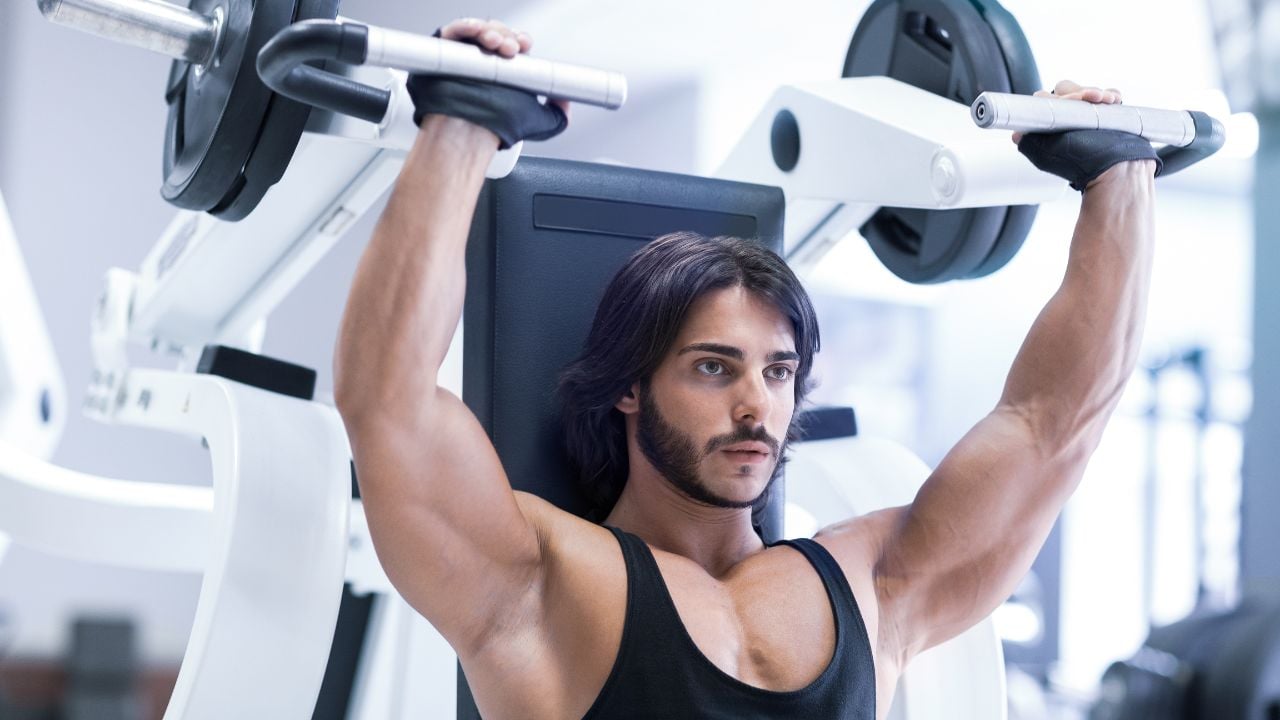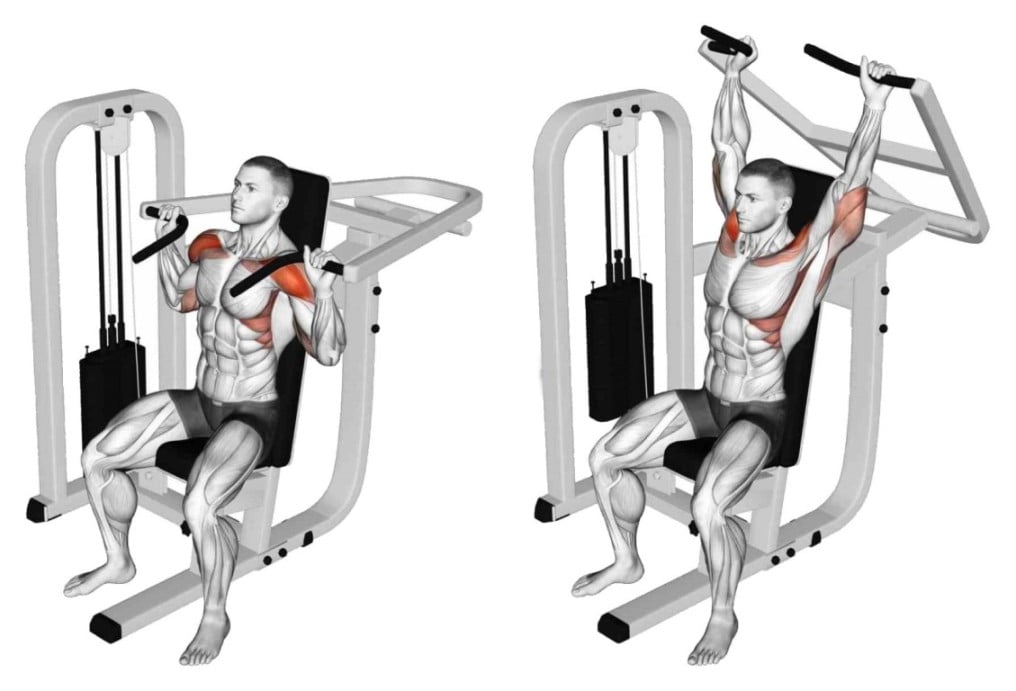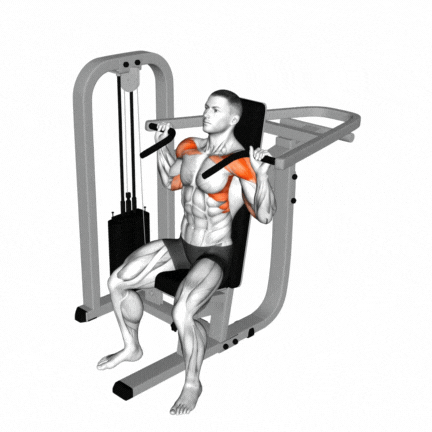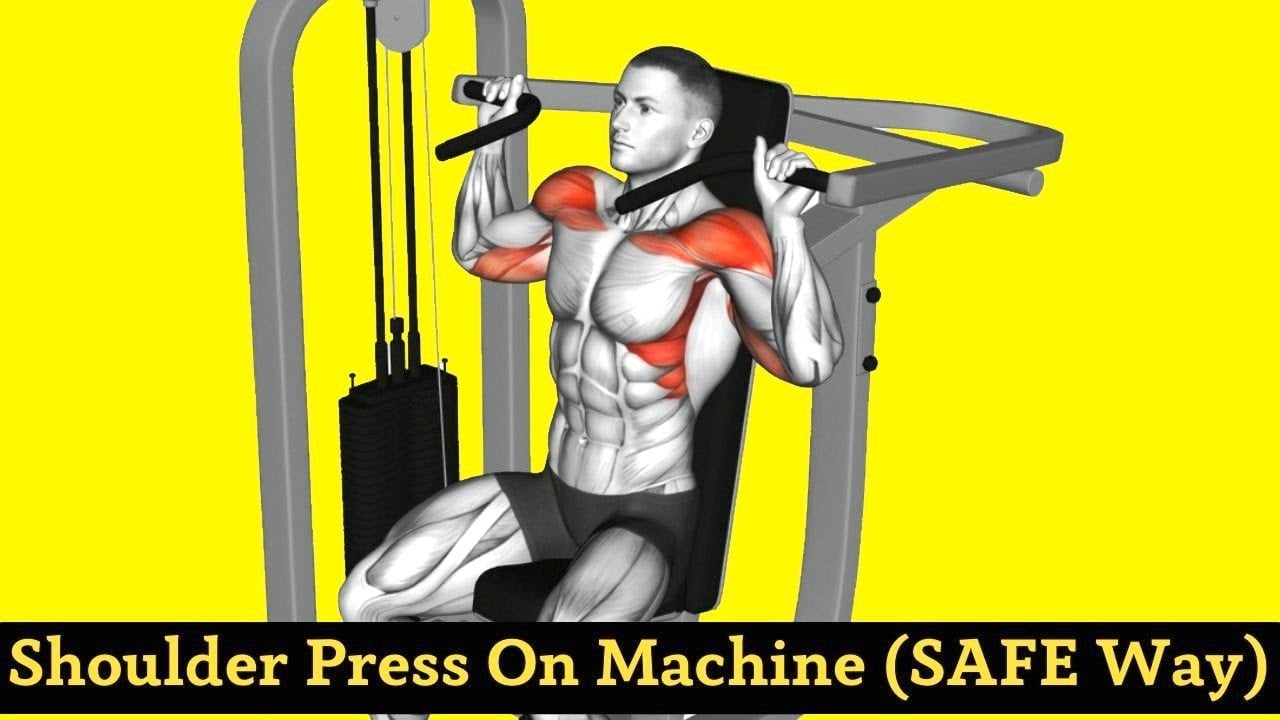The shoulder press machine, also known as the military press machine or seated shoulder press, is a staple in gyms and fitness centres to target the deltoid muscles through vertical pressing movements.
This machine eliminates the need for stabilisation, allowing you to focus entirely on the pressing motion while maintaining proper form.
This machine is specifically designed to target the shoulder muscles, providing a controlled environment for overhead pressing movements. It is an excellent exercise for building the front and side deltoid muscles.
Machine presses are better than free-weight presses because they are stable and safer.
They also offer a choice of handgrips. A neutral grip (palms facing together) focuses more on the anterior deltoid better than a pronated grip (palms forward).
This exercise requires rigorous movement because the bar is fixed to the rack, and the weights can be lowered significantly. This provides a good stretch for the front deltoid muscles.

Shoulder Press Machine Hand Position
- Standard Grip (Overhand): Hands slightly wider than shoulder-width. This grip primarily targets the anterior deltoids, while also engaging the triceps and upper chest to a lesser extent.
- Neutral Grip (Palms Facing Each Other): Palms face each other (hammer grip). It engages the anterior and lateral deltoids more evenly than the overhand grip. Reduces stress on the wrists and elbows.
- Narrow Grip (Underhand, Palms Facing Up): Hands close together. It increased focus on the triceps and front deltoids.

Shoulder Press Machine Muscles Worked
The shoulder press machine is a versatile strength training exercise that targets several muscle groups:
Primary Muscles Targeted
- Deltoids: The deltoids are the major muscles of your shoulder and consist of three sections:
- Anterior Deltoid (Front): Heavily engaged throughout the press.
- Medial Deltoid (Side): Contributes significantly to the pressing motion.
- Posterior Deltoid (Rear): Involved to a lesser extent but still provides stabilisation.
Secondary Muscles
- Triceps: Your triceps extend your elbows and play a significant supporting role in the shoulder press machine.
- Upper Chest: Assists in the pressing movement, especially in the initial phase of the exercise.
Stabilizing Muscles
- Trapezius and Rhomboids (Upper Back): These muscles help maintain posture and shoulder stability.
- Core Muscles: Your core muscles (abdominals, obliques, lower back) engage to keep your body stable during the exercise.
How To Do Shoulder Press With Machine

- Adjust the seat so that when you are sitting with your back firmly against the backrest, the handles are at or slightly below shoulder level.
- Ensure your entire back is firmly pressed against the backrest, with particular attention to the lower back. This provides stability and prevents excessive lumbar extension (arching of the lower back).
- Plant your feet flat on the floor, roughly shoulder-width apart. This creates a stable base, allowing for better force transfer throughout your body.
- Depending on the machine’s design and your personal preferences or goals, choose either an overhand (pronated) or neutral grip. As discussed earlier, the neutral grip is often more shoulder-friendly.
- Take a deep breath and brace your core. This creates intra-abdominal pressure, further stabilising your torso.
- Press the handles directly overhead in a controlled manner. Visualise driving the weight straight up. Your arms should extend until they are almost entirely straight, but avoid locking your elbows at the very top.
- Your elbows should track slightly forward of your torso, not flaring out directly to the sides. This alignment is more biomechanically favourable for the shoulder joint and reduces stress on the rotator cuff.
- Exhale and slowly lower the handles back to the starting position. Control the weight throughout the entire descent.
- Lower the handles until they are at or just below shoulder level. Avoid going excessively deep if it causes discomfort or compromises your form.
- This is one rep. Complete as many repetitions as you can fit in a set.
Tips and Form
- Before touching the machine, perform 5-10 minutes of light cardio to increase blood flow. Perform exercises that target your rotator cuff muscles, such as internal and external rotations.
- Sit with your back flat against the pad, chest lifted, and core engaged. Avoid excessive arching of your lower back (lumbar hyperextension) or rounding of your upper back (thoracic kyphosis). A neutral spine ensures optimal force transfer and protects your spinal discs.
- Avoid hunching your shoulders up towards your ears. Keep your shoulder blades pulled back and down slightly.
- As you press the weight overhead, allow your shoulder blades to naturally upwardly rotate and protract. This movement is essential for maintaining proper glenohumeral rhythm and preventing impingement.
- Your elbows should track slightly forward of your torso, not flaring out to the sides. Avoid locking your elbows at the top.
- Keep your head neutral and look straight ahead. Avoid tucking your chin or craning your neck.
- Maintain a firm but comfortable grip on the handle. Experiment with various positions, including wide, neutral, and narrow, to determine what works best for you.
- Use full range of motion, pressing from shoulder level up to about eye level.
- Try to create a mind-muscle connection and feel your shoulder muscles working, rather than just moving the weight.
- Inhale as you lower the weight (eccentric phase) and exhale forcefully as you press the weight overhead (concentric phase). This helps stabilize your core and provides energy for the lift.
- Start with a lighter weight if you’re new to the exercise. It’s wise to have a spotter for assistance when attempting to lift heavy weights.
To Stay Motivated: 150+ Gym Workout Motivational Quotes To Stay Fit

Manish is a NASM-certified fitness and nutrition coach with over 10 years of experience in weight lifting and fat loss fitness coaching. He specializes in gym-based training and has a lot of knowledge about exercise, lifting technique, biomechanics, and more.
Through “Fit Life Regime,” he generously shares the insights he’s gained over a decade in the field. His goal is to equip others with the knowledge to start their own fitness journey.

